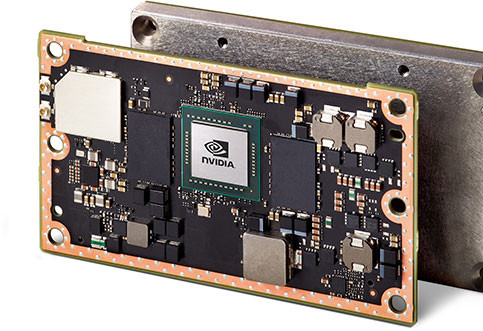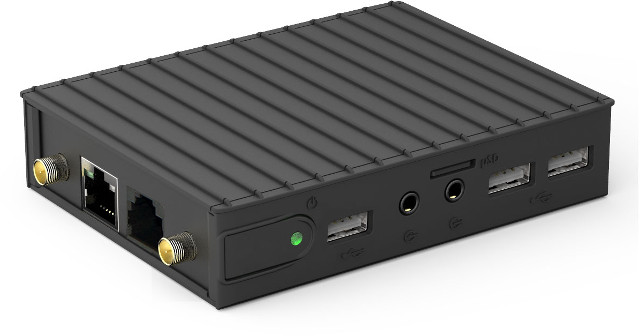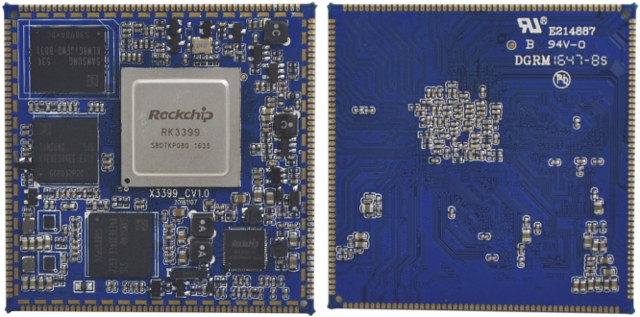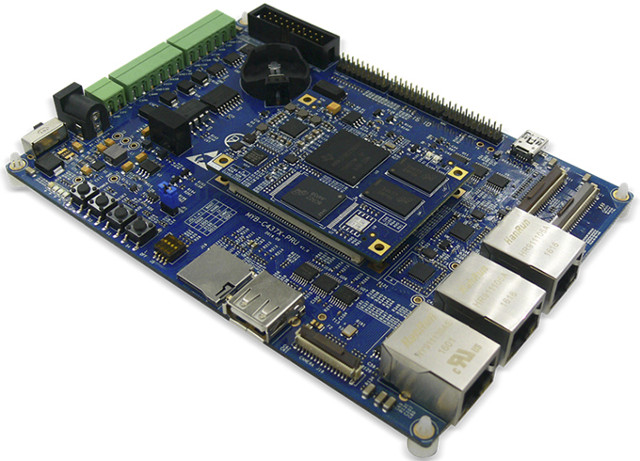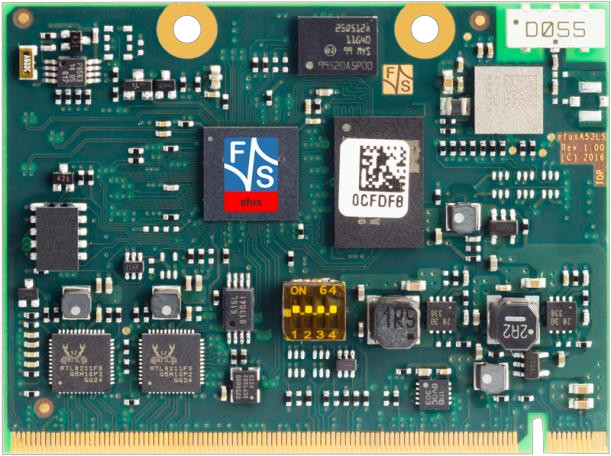MYIR Tech has released MYC-JA5D2X system-on-module powered by a Microchip Atmel SAMA5D2 ARM Cortex A5 processor with 256MB flash, and 256 MB DDR3. The module relies on a SO-DIMM edge connector to expose the camera interface, Ethernet, USB, camera, and other I/O signals. MYC-JA5D2X CPU module specifications: SoC – Atmel SAMA5D26 or SAMA5D27 ARM Cortex A5 processor @ up to 500 MHz with 128KB L2 cache System Memory – 256MB DDR3 SDRAM Storage – 256MB NAND flash, 4MB data flash, 64KB EEPROM Connectivity – On-board 10/100M Ethernet PHY 200-pin SO-DIMM edge connector with: 1x Ethernet 1x USB Host, 1x USB Device, 1x USB HSIC (HSIC is only for SAMA5D27) Up to 10x serial ports, up to 2 x CAN (only for SAMA5D27) Up to 7 x I2C, up to 7 x SPI Up to 2 x QSPI 12 x 12-bit ADC (enhanced resolution up to 14 bits) 4x PWM 1x […]
NVIDIA Introduces Jetson TX2 Embedded Artificial Intelligence Computer
NVIDIA has just announced an upgrade to to their Jetson TX1 module, with Jetson TX2 “Embedded AI Computer” with Tegra X2 Parker SoC that either doubles the performance of its predecessor, or runs at more than twice the power efficiency, while drawing less than 7.5 watts of power. The company provided a comparison showing the differences between TX1 and TX2 modules. Jetson TX2 Jetson TX1 GPU NVIDIA Pascal, 256 CUDA cores NVIDIA Maxwell, 256 CUDA cores CPU HMP Dual Denver 2/2 MB L2 + Quad ARM® A57/2 MB L2 Quad ARM® A57/2 MB L2 Video 4K x 2K 60 Hz Encode (HEVC) 4K x 2K 60 Hz Decode (12-Bit Support) 4K x 2K 30 Hz Encode (HEVC) 4K x 2K 60 Hz Decode (10-Bit Support) Memory 8 GB 128 bit LPDDR4 58.3 GB/s 4 GB 64 bit LPDDR4 25.6 GB/s Display 2x DSI, 2x DP 1.2 / HDMI 2.0 / […]
Compulab IOT-GATE-iMX7 is an NXP i.MX7 IoT Gateway for Industrial Applications
CompuLab has introduced IOT-GATE-iMX7 compact fanless IoT gateway and industrial controller built around the company’s CL-SOM-iMX7 system-on-module, and offering Ethernet, WiFi, Bluetooth, 3G and Zigbee connectivity.Compulab IOT-GATE-iMX7 gateway specifications: SoC – NXP i.MX 7 dual ARM Cortex-A7 processor @ up to 1GHz with ARM Cortex-M4 core @ 200Mhz, 2D graphics engine System Memory – Up to 2GB DDR3L-1066 Storage – Up to 32GB on-board eMMC + micro-SD socket Connectivity Dual Gigabit Ethernet Dual band WiFi 802.11 a/b/g/n Bluetooth 4.1 BLE Optional 3G cellular module via mini PCie socket Optional ZigBee NXP JN5168 module Display – DVI up to 1920×1080 using a HDMI connector Audio – 3.5mm jacks for stereo line out, stereo line in USB – 4x USB2.0 host ports, type-A connectors Serial – 1x RS485 / RS422 port, RJ11 connector; 1x RS232 port, ultra-mini serial connector; 1x serial console via UART-to-USB bridge, micro-USB connector Expansion mini-PCIe socket, full-size embedded […]
Trenz Electronic TE0808 UltraSOM+ is a Xilinx Zynq Ultrascale+ ZU9EG System-on-Module
Xilinx Zynq Ultrascale+ ARM Cortex A53 + FPGA SoC have now started to show up in boards such as AXIOM Board based on Zynq Ultrascale+ ZU9EG. Price for the board has not been announced, and while a similar Xilinx development kit goes for close to $3,000, some people are expecting the board to sell for $400 to $600. Since the price of FPGA vary a lot from a few dollars to $40,000 for the top end chips, I decided to find pricing info about Xilinx Zynq Ultrascale+ MPSoCs which lead me to Trenz Electronic TE0808 system-on-module, which was unveiled in May last year, and I’ll cover in the second part of this post, after – hopefully quickly – describing Zynq Ultrascale+ family and nomenclature, and addressing the price “issue”. First, there are three sub-families within Zynq Ultrascale+ MPSoC portfolio: CG models with 2x Cortex A53, 2x Cortex R5, FPGA fabric […]
9Tripod X3399 SoM and Development Board are Powered by Rockchip RK3399 Hexa Core Processor
9Tripod (九鼎创展) has just launched X3399 system-on-module powered by Rockchip RK3399 hexa-core Cortex A72/A53 processor, and as well as a corresponding development board for people wanted to get started quickly before designing their own baseboard. X3399 core board preliminary specifications: SoC – Rockchip RK3399 hexa-core big.LITTLE processor with two ARM Cortex A72 cores up to 2.0 GHz, four Cortex A53 cores, and a ARM Mali-T860 MP4 GPU with OpenGL 1.1 to 3.1 support, OpenVG1.1, OpenCL and DX 11 support System Memory – 2GB LPDDR3 (2x Samsung K4E8E304EE-EGCF) Storage – 8GB eMMC 5.0 flash (Samsung KLM8G1GEND-B031) IOs – 204-pin to be soldered on baseboard PMIC – Rockchip RK808-D Dimensions – 55×55 mm 9Tripod does have a forum in English, but the company provides most of the information in Chinese. I could not find details about Linux or Android images and source code, except a few mentions of Linux Qt, Ubuntu, and […]
MYD-C437x-PRU Development Board Leverages TI Sitara AM437x Programmable Real-time Unit
MYIR Technologies launched MYC-C437x system-on-module based on TI Sitara AM437X processor, and the corresponding MYD-C437x development board at the end of 2015, but the latter did not make use of the processor’s PRU-ICSS (Programmable Real-Time Unit Subsystem and Industrial Communication SubSystem) block. The company has now released a new version of the baseboard called MYC-C437x-PRU which exposes I/Os pins to leverage the PRU-ICSS and enable implementation of protocols like EtherCAT and Profibus.MYD-C437x-PRU industrial development board specifications: System-on-Module – MYC-C437x module with SoC – Texas Instruments AM437x ARM Cortex A9 processor @ up to 1GHz with PowerVR SGX530 GPU (AM4378/AM4379 only) System Memory – 256 or 512MB (default) DDR3 SDRAM Storage – 4GB eMMC Flash (reserved 256/512MB Nand Flash design), 16MB QSPI Flash (unpopulated by default), 32KB EEPROM Connectivity – Gigabit Ethernet PHY Storage – 1x micro SD slot Serial ports – 1x 3-wire RS232 debug serial port, 2x 5-wire RS232 serial […]
Samsung Introduces Artik 530 IoT Module & Development Kit with WiFi, BLE, and Zigbee/Thread
Samsung unveiled Artik 1, Artik 5, and Artik 10 IoT modules & development board families in 2015, but since then they dropped the Artik 1 family, and instead launched Artik 0, Artik 5, and Artik 7 modules and boards late last year. More recently the company canceled the more powerful Artik 1020 development board, but the Artik project is still going on, as they’ve just added Artik 530 module & development kit to their Artik 5 family. Samsung ARTIK 530 module specifications: SoC – Unnamed Quad core ARM Cortex A9 processor @ 1.2 GHz with a 3D graphics accelerator System Memory – 512 MB DDR3 Storage – 4GB eMMC v4.5 flash Connectivity – Dual band SISO 802.11 a/b/g/n WiFi, Bluetooth 4.2 LE + Classic, 802.15.4/Zigbee/Thread, 10/100/1000M MAC (external PHY required) Other Interfaces and peripherals Camera – 4-lane MIPI CSI up to 5MP (1920×1080 @ 30fps) Display – 4-lane MIPI DSI […]
F&S Elektronik Introduces efus A53LS NXP QorIQ LS1012A System-on-Module for Communication & Networking Applications
NXP QorIQ LS1012A is a single core Cortex A53 communication processor that offers a 64-bit update to LS1021A dual core Cortex A7 processors found in gateways such as NXP LS1021A-IOTA IoT gateway reference design, and F&S Elektronik System has just launched efus A53LS system-on-module powered by the processor with up to 1GB RAM, up to 64SQPI NOR, access to the communication interfaces and peripherals from the processor via an efus compliant edge connector, and long term availability until 2030. efus A53LS COM specifications: Processor – NXP QorIQ Layerscape LS1012A single core ARM Cortex-A53 @ up to 800MHz System Memory – 512MB DDR3 by default, supports up to 1GB DDR3 RAM Storage – Up to 64MB QSPI NOR flash on-module, I/Os for SATA and SD card on edge connector Connectivity – 2x Realtek RTL8211F(N) Gigabit Ethernet transceiver chips, optional wireless module with dual WiFi IEEE802.11b/g/n/ac and Bluetooth 4.0 LE efus edge […]



